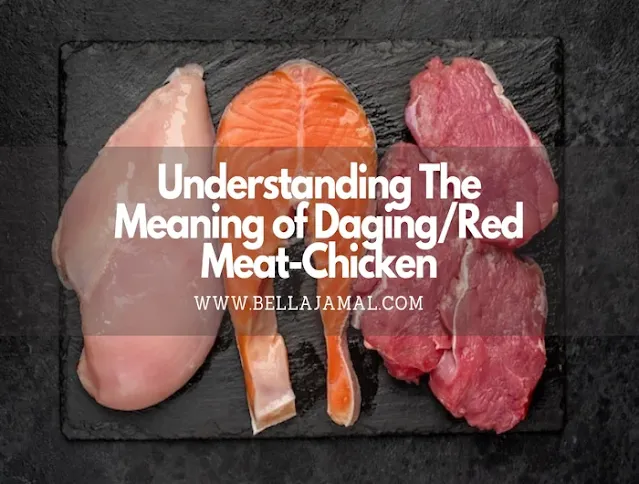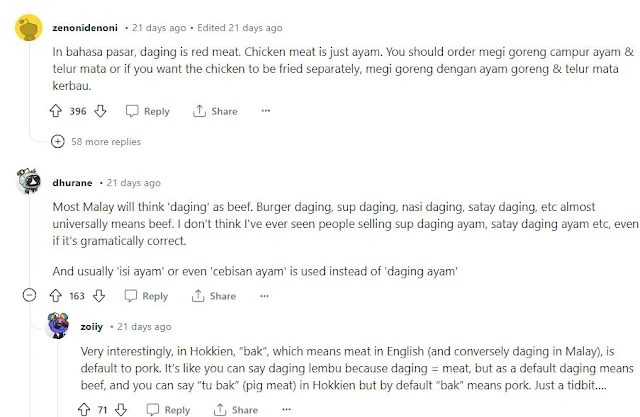Malaysian cuisine is a rich tapestry of flavors, textures, and traditions, but
for those from different cultural backgrounds, ordering food in local eateries
can sometimes lead to unexpected surprises. In this article, we'll explore the
intricacies of ordering food in Malay restaurants, focusing on understanding
the term "daging" and how it relates to various types of meat.
Cultural Sensitivity in Food Choices
Malaysia is a diverse country with people of various ethnicities and religious
beliefs, including Chinese Buddhists who abstain from consuming beef or
buffalo (lembu/kerbau) meat due to religious reasons. For these individuals,
selecting dishes that align with their dietary restrictions is of utmost
importance.
The Confusion Surrounding "Daging"
A common point of confusion for non-Malay diners, such as our Chinese Buddhist
friend, is the meaning of the term "daging." In everyday Malay conversation,
"daging" often refers to
beef
or red meat. Dishes like "burger daging," "sup daging," "nasi daging," and
"satay daging" are almost universally associated with beef. This can lead to
misunderstandings when ordering food in a Malay restaurant.
Our friend's experience at a Malay restaurant is a perfect example of this
confusion. When they ordered "maggi goreng dengan daging ayam dan telur mata"
(fried noodles with chicken meat and a sunny-side-up egg), they expected to
receive only chicken meat but were surprised to find beef alongside it. When
they questioned the staff, they were told that "daging" referred to meat in
general, including both chicken and beef.
Language Variations and Defaults
It's essential to understand that language can be a complex matter, with words
often having varying interpretations based on context and regional dialects.
For example, in Hokkien, the word "bak" is used to refer to meat, but by
default, it means pork. You can say “tu bak” (pig meat) in Hokkien but by
default "bak" means pork.
In Malay, "daging" is the default term for meat, yet it is typically
associated with beef or red meat in everyday conversation. Meanwhile, in Thai,
"keat" defaults to beef, despite pork being the more popular meat.
Clarifying Your Orders
To avoid misunderstandings, it's crucial to be specific when ordering dishes.
For those who prefer chicken over beef, you can use phrases like "maggi goreng
campur ayam & telur mata" (fried noodles with chicken and a sunny-side-up
egg) or "maggi goreng dengan ayam goreng & telur mata kerbau" (fried
noodles with fried chicken and a
sunny-side-up egg
alongside beef).
"In bahasa pasar, daging is red meat. Chicken meat is just ayam. You should order megi goreng campur ayam & telur mata or if you want the chicken to be fried separately, megi goreng dengan ayam goreng & telur mata kerbau."
Additionally, specifying "isi ayam" or even "cebisan ayam" when ordering ensures that you receive chicken meat in your dish without any ambiguity.
"Most Malay will think 'daging' as beef. Burger daging, sup daging, nasi daging, satay daging, etc almost universally means beef. I don't think I've ever seen people selling sup daging ayam, satay daging ayam etc, even if it's gramatically correct. And usually 'isi ayam' or even 'cebisan ayam' is used instead of 'daging ayam'."
Read more > Maggi Kari Nyonya Recipe
"You could order like this next time. "Boss bagi maggi.. letak ayam" or "Boss bagi maggi dengan ayam".. instead of "Boss bagi maggi ayam" in which you will get maggi ayam stock.. You are not wrong, daging is meat, not necessarily beef / red meat but in everyday conversation daging usually refers to beef, and ayam is just ayam or ayam goreng, ayam bakar, sup ayam. If beef, it'll be daging goreng, daging bakar, sup daging etc."
When ordering satay, the same principle applies: "satay daging" typically
means beef satay, "satay ayam" refers to chicken satay, and "satay kambing"
is mutton satay.
Conclusion
Malaysian cuisine
offers a delightful mix of flavors and ingredients that cater to diverse
tastes and preferences. For those who have dietary restrictions or specific
preferences, understanding the nuances of language and ordering practices
can help make dining experiences in Malay restaurants more enjoyable and
free from confusion.
In essence, when dining out, remember that "daging" may often default to
beef, but you can easily specify your preferences to ensure your meal aligns
with your cultural or dietary requirements. By doing so, you can savor the
delicious offerings of Malaysian cuisine without any unwelcome surprises.
Source: https://www.reddit.com/
Understanding the Meaning of Daging Meat, Understanding the Meaning of Daging Food, Daging Meaning Malay, Daging is Beef, Daging Lembu in English, Beef In Malay, Daging Meaning in English,
Tags:
Beef In Malay
Daging is Beef
Daging Lembu in English
Daging Meaning Malay
Makan Place
Understanding the Meaning of Daging Food
Understanding the Meaning of Daging Meat


